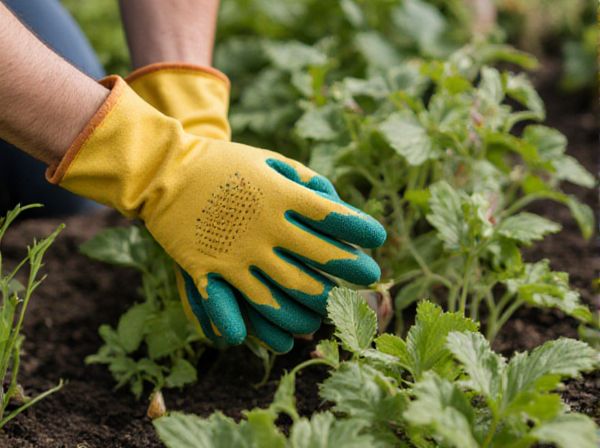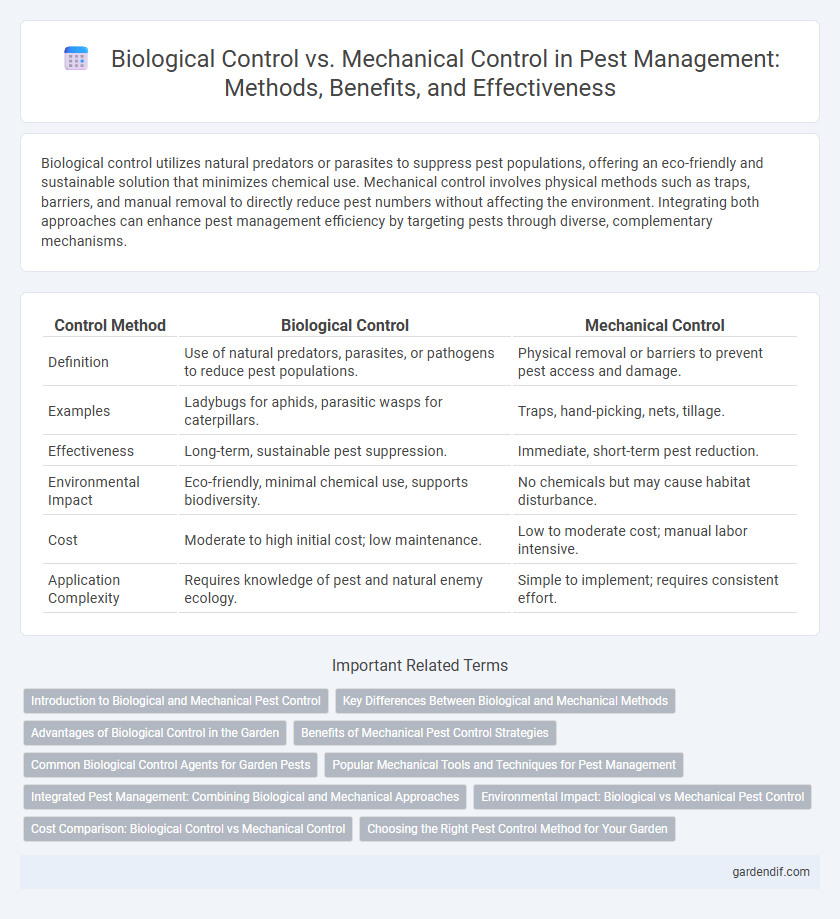
Biological Control vs Mechanical Control Illustration
Biological control utilizes natural predators or parasites to suppress pest populations, offering an eco-friendly and sustainable solution that minimizes chemical use. Mechanical control involves physical methods such as traps, barriers, and manual removal to directly reduce pest numbers without affecting the environment. Integrating both approaches can enhance pest management efficiency by targeting pests through diverse, complementary mechanisms.
Table of Comparison
| Control Method | Biological Control | Mechanical Control |
|---|---|---|
| Definition | Use of natural predators, parasites, or pathogens to reduce pest populations. | Physical removal or barriers to prevent pest access and damage. |
| Examples | Ladybugs for aphids, parasitic wasps for caterpillars. | Traps, hand-picking, nets, tillage. |
| Effectiveness | Long-term, sustainable pest suppression. | Immediate, short-term pest reduction. |
| Environmental Impact | Eco-friendly, minimal chemical use, supports biodiversity. | No chemicals but may cause habitat disturbance. |
| Cost | Moderate to high initial cost; low maintenance. | Low to moderate cost; manual labor intensive. |
| Application Complexity | Requires knowledge of pest and natural enemy ecology. | Simple to implement; requires consistent effort. |
Introduction to Biological and Mechanical Pest Control
Biological pest control utilizes natural predators, parasites, or pathogens to manage pest populations, promoting ecological balance without harmful chemicals. Mechanical pest control involves physical methods such as traps, barriers, or manual removal to reduce pest presence efficiently. These integrated pest management strategies offer sustainable alternatives to chemical pesticides, enhancing crop protection and environmental health.
Key Differences Between Biological and Mechanical Methods
Biological control involves using natural predators, parasites, or pathogens to reduce pest populations, promoting ecological balance and sustainability. Mechanical control relies on physical methods such as traps, barriers, or manual removal to directly eliminate pests without chemical use. Key differences include the reliance on living organisms in biological control versus the physical, human-applied techniques characteristic of mechanical control.
Advantages of Biological Control in the Garden
Biological control in the garden uses natural predators and parasites to manage pest populations, reducing the need for harmful chemical pesticides and promoting ecosystem balance. This method enhances soil health and biodiversity by preserving beneficial insects and microorganisms, leading to sustainable pest management. It offers a safer, environmentally friendly solution that minimizes pesticide resistance and supports long-term garden productivity.
Benefits of Mechanical Pest Control Strategies
Mechanical pest control strategies offer immediate and precise removal of pests through methods such as traps, barriers, and manual elimination, reducing the reliance on chemical pesticides. These techniques minimize environmental impact, preserve beneficial organisms, and prevent chemical resistance development in pest populations. Implementation of mechanical controls enhances integrated pest management by promoting sustainable and eco-friendly pest suppression.
Common Biological Control Agents for Garden Pests
Common biological control agents for garden pests include beneficial insects such as lady beetles, predatory mites, and parasitic wasps, which naturally suppress pest populations by preying on aphids, spider mites, and caterpillars. Nematodes offer an effective soil-based solution against root-feeding pests like grubs and larvae by invading and killing them without harming plants. Employing these biological controls enhances garden health by reducing reliance on chemical pesticides and promoting sustainable pest management.
Popular Mechanical Tools and Techniques for Pest Management
Popular mechanical tools and techniques for pest management include traps, barriers, and physical removal methods, which effectively reduce pest populations without chemical intervention. Common tools such as sticky traps, hand-picking, and row covers provide targeted control by preventing pest access or directly capturing insects. These methods support integrated pest management by minimizing environmental impact and enhancing sustainability in agricultural and garden settings.
Integrated Pest Management: Combining Biological and Mechanical Approaches
Integrated Pest Management (IPM) effectively combines biological control agents such as predators, parasites, or pathogens with mechanical methods like traps, barriers, and manual removal to reduce pest populations. This synergy enhances pest suppression while minimizing chemical pesticide use, promoting environmental sustainability and crop health. Employing both strategies in IPM improves long-term pest management by targeting multiple pest life stages and reducing resistance development.
Environmental Impact: Biological vs Mechanical Pest Control
Biological pest control utilizes natural predators, parasites, or pathogens to reduce pest populations, significantly minimizing chemical pesticide use and preserving soil and water quality. Mechanical control methods, such as traps, barriers, or manual removal, have lower chemical residues but can disturb habitats and require substantial labor inputs, potentially impacting non-target species. Both methods offer eco-friendly alternatives to chemical pesticides, yet biological control typically results in longer-term ecological balance and biodiversity enhancement.
Cost Comparison: Biological Control vs Mechanical Control
Biological control typically incurs lower long-term costs due to sustainable pest population management using natural predators or parasites, minimizing the need for repeated interventions. Mechanical control often involves higher immediate expenses linked to labor, equipment, and ongoing maintenance for physical pest removal or barriers. Studies show that biological control's cost-effectiveness improves over time, whereas mechanical control demands consistent financial input, making it less economical for large-scale or persistent infestations.
Choosing the Right Pest Control Method for Your Garden
Selecting the appropriate pest control method for your garden depends on pest severity, crop type, and environmental impact. Biological control uses natural predators or parasites to reduce pest populations, promoting sustainable and eco-friendly gardening. Mechanical control involves physical removal or barriers, offering immediate results without chemicals but may require more labor and regular maintenance.
Biological Control vs Mechanical Control Infographic

 gardendif.com
gardendif.com